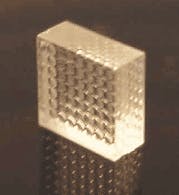Replication of micro-optics is cost-effective
Micro-optical components are widely used as building blocks in many commercial applications. Components such as one- and two-dimensional diffraction gratings, subwavelength gratings, microlenses, and microprisms enable a large category of novel optical functions. These components can be used to split a laser beam into almost arbitrary patterns of spots or to transform a Gaussian beam into a tophat profile, as well as to replace conventional optical systems with compact and lightweight planar systems.
Micro-optical elements are traditionally made by etching fused silica. While this process produces precise components, it can be expensive and inflexible. The process also produces components that have a fixed index of refraction and a fixed thermal-expansion coefficient.
Replication techniques such as ultraviolet (UV) embossing or injection molding of polymers and sol-gel materials not only overcome these disadvantages but also allow the manufacture of high-precision double-sided components, eliminating the need to fix and align adjacent components. Micro-optical components produced using this replication technique have a precision comparable to that of fused-silica components, but typically cost only 10% to 20% as much. This is because replication equipment costs less than lithography and plasma-etching equipment and the throughput per machine is higher.
Replicating double-sided components
null
The introduction of double-sided components opens up a multitude of new applications (see Fig. 1). For example, by replicating on both sides of a substrate, a beamsplitter grating can be combined with focusing microlenses on the back surface. Alternatively, the front surface can be a diffractive lens and the back surface a refractive lens. Such hybrid solutions can be designed to behave athermally or achromatically—both useful properties for imaging in outdoor conditions, for example.
Ultraviolet embossing allows double-sided refractive and diffractive optical elements to be fabricated by a wafer-scale replication process that combines the high alignment and positioning accuracy of photolithographic processes with the low fabrication costs of a replication process. This combination of high precision and low cost means these components are ideal for data communications and telecommunications applications.
The replication process allows the designer to choose a substrate that is compatible with other materials and processes in the whole optoelectronic system. For example, the designer can choose a material with the appropriate index of refraction and thermal-expansion coefficient. Ultraviolet embossing also allows certain properties to be added to the components during manufacture; for example, subwavelength gratings can be incorporated into a component to give it antireflective properties.
null
In replication by UV embossing, microstructures are copied into a thin film of UV-curable epoxy resin (see Fig. 2). The substrate can range from a standard glass plate to a high-precision, machined refractive optical element such as a prism or lens. The thickness and uniformity of the replicated film can be controlled to form an overall surface planar to a fraction of a micron over areas of some millimeters—comparable to the quality of etched components in fused silica.
Double-sided replicas are obtained either by a simultaneous replication process on both sides of the substrate or by processing the two sides separately (see Fig. 2). In both cases, the alignment of front and back structures is achieved with specially designed alignment marks. It is very important that they be detected and analyzed with submicron resolution even through substrates with a thickness of several millimeters.
Accuracy a must
To achieve a high yield in the fabrication of high volumes of micro-optical modules, the fabrication process must meet very high standards of accuracy and reproducibility. Such requirements call for the construction of extremely stable and rigid mechanical holders for replication tools and substrates. Because the two replication tools themselves can shift during the replication process (most likely during the mold separation), online control of the alignment and a precise offline measurement of the alignment accuracy must be used. Heptagon has invested extensive efforts to reach better than 5-µm accuracy between the optical axes on front and back surfaces with a semiautomated replication process.
If the temperature resistance of commercial polymers is not suitable for the application, another group of moldable materials can be used: sol-gel composites. Sol-gel is a general name for a process that generates materials that can be processed in many ways like UV-curable polymers, but whose optical and mechanical properties resemble those of glass.
Further significant cost savings can be achieved when double-sided replication is extended to wafer scale—that is, to at least 4-in.-diameter wafers. All subsequent processing steps like metallization or different coatings are done on the full wafers prior to dicing. Thus, a large quantity of fully functional optical modules can be fabricated in one replication step. Scaling up to larger areas raises new technical challenges—especially the maintenance of uniform component quality over the whole wafer.
When even larger volumes—typically hundreds of thousands to millions of units—are needed, an additional economically feasible solution is injection molding of all-plastic pieces, such as polycarbonate or acrylics. Heptagon is pursuing technologies to transfer the high quality of one- and two-sided replicated micro-optics into injection-molded pieces.
Fixing the replication tools inside the mold cavity is challenging because of the stringent alignment requirements between the two surfaces of the module. When components are produced in quantities of millions, however, the unit price can be as small as a fraction of a dollar, so initial costs are quickly paid back.
Replication techniques must allow the manufacture of highly accurate microstructures over a large area. For double-sided replicas, the technique must allow for variation in the substrate thickness, must align the front and back optical axes to an accuracy better than 2 µm, and must be capable of producing components with a planarity better than ±5 µm. While injection molding can guarantee the precision of microscopic features, the only replication technique that meets all requirements for the production of double-sided elements—including planarity, dimensional accuracy, mechanical features, and the final element price—is UV embossing.
Materials and environmental requirements
In addition to meeting precise dimensional requirements, replicated micro-optical components must also meet strict environmental specifications. Important material parameters include stability, lifetime properties, thermal properties, adhesion, and optical performance. Most commercially available UV-curable polymer materials do not fully withstand such conditions.
Antireflection coatings, for example, are the cause of failures in some environmental tests. Coating-material combinations have been shown to be vulnerable to high humidity, thermal shocks, and strong mechanical stresses such as those occurring during the final dicing procedure. Promising results have been obtained with new materials like sol-gel composites, however. These liquid organic-inorganic materials cure under UV and/or thermal treatment to hard, stable, glasslike films with good temperature stability. Long-term strife tests have shown excellent results. Replicated micro-optical components and systems are therefore ready for applications in telecom and datacom.
MARKUS ROSSI is production director at Heptagon, Badenerstrasse 569, CH-8048, Zurich, Switzerland; and JYRKI SAARINEN is senior vice president of strategic business development at Heptagon, Tekniikantie 12, FIN-02150, Espoo, Finland; e-mails: [email protected] and [email protected].
Nontraditional optics find new uses
Traditional ground and polished optics are being augmented by their modern counterparts, which include micro-optics and diffractive optics. These two articles delve into the world of nontraditional optics—the first describing the fabrication of micro-optics by embossing or injection molding, and the second outlining the use of diffractive as well as conventional optics for laser-beam shaping.


